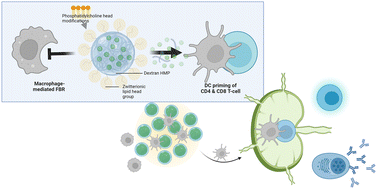Vaccine delivery by zwitterionic polysaccharide-based hydrogel microparticles showing enhanced immunogenicity and suppressed foreign body responses†
Abstract
The controlled release of antigens from injectable depots has been actively pursued to achieve long-lasting immune responses in vaccine development. Nonetheless, subcutaneous depots are often susceptible to foreign body responses (FBRs) dominated by macrophage clearance and fibrotic encapsulation, resulting in limited antigen delivery to target dendritic cells (DCs) that bridge innate and adaptive immunity. Here, we aim to develop a long-term antigen depot that can bypass FBR and engage DCs to mature and migrate to lymph nodes to activate antigen-specific T-cells. Leveraging the immunomodulatory properties of exogenous polysaccharides and the anti-fouling characteristics of zwitterionic phosphorylcholine (PC) polymers, we developed a PC functionalized dextran (PCDX) hydrogel for long-term antigen delivery. We observed that PCDX in both injectable scaffold and microparticle (MP) forms could effectively evade FBR as the anionic carboxymethyl DX (CMDX) in vitro and in vivo. Meanwhile, PCDX provided slower and longer release of antigens than CMDX, resulting in local enrichment of CD11c+ DCs at the MP injection sites. DC cultured on PCDX exhibited stronger immunogenic activation with higher CD86, CD40, and MHC-I/peptide complex than CMDX. PCDX also generated DC with greater propensity in migration to lymph nodes, as well as antigen presentations to trigger both CD4+ and CD8+ arms of T-cell responses, as compared to other charge derivatives of DX. Besides cellular responses, PCDX could also induce more durable and potent humoral responses, with higher levels of antigen specific IgG1 and IgG2a by day 28, as compared to other treatment groups. In conclusion, PCDX can incorporate the benefits of both immunogenic DX and anti-fouling properties of zwitterionic PC and thus, shows great promise in providing long-term delivery of antigens for vaccine development.

- This article is part of the themed collection: Biomaterials Science Recent HOT Articles


 Please wait while we load your content...
Please wait while we load your content...